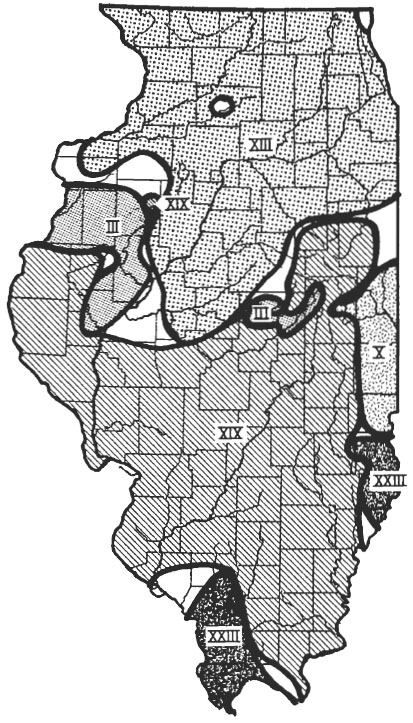The Mississippi Valley Brood
Brood XXIII contains the species Magicicada neotredecim, Magicicada tredecim, Magicicada tredecassini, and Magicicada tredecula although only populations in the contact zone contain all four species. Brood XXIII has a small disjunct in Weldon Springs State Park, DeWitt County, IL.
In the map below, cicada symbols are verified presence records and red symbols are verified absence records in our database as of March 2025. Click on points for details. Gold symbols are from Simon (1988); smaller symbols are records with a lower degree of certainty and black crosses represent records that are considered spurious. Blue symbols are from Marlatt (1923); smaller symbols are records with a lower degree of certainty and question marks represent records that are considered spurious. Purple symbols and shading represent Stannard’s (1975) delineation of the brood in Illinois. Areas that Stannard incorrectly attributed to Brood III are also included as green symbols and shading. Symbols are in layered in the order Database, Simon, Marlatt, Stannard and symbols in the upper layers may obscure symbols in lower layers. Some absence records in the database are not shown for clarity. Note that the dates shown do not represent dates of adult emergence; rather, they represent dates on which choruses were active. Thus, in any given area, adult emergence may have occurred a week or more earlier than the dates shown on this map. This map may not be reproduced without written permission.

Illinois presents a particular challenge for understanding periodical cicada biology, because it contains both 13 and 17 year life cycles, all 7 currently recognized species, found in five separate broods, some of which include disjunct populations.
Stannard (1975) published a map of all Illinois periodical cicada broods. Brood XXIII has a small northern disjunct in DeWitt County; Stannard attributed these populations to 17-year Brood III, but they belong to Broods XIX and XXIII instead.
Reproductive Character Displacement
An interesting feature of Broods XIX and XXIII is a striking pattern of reproductive character displacement (RCD). Where Magicicada neotredecim is in contact with another 13-year species, M. tredecim, the dominant male call pitch of M. neotredecim is approximately 1.7 kHz, while outside the contact zone, its call pitch is approximately 1.4 kHz, identical to that of its putative ancestor, M. septendecim; female pitch preferences match (Marshall and Cooley 2000).
You can read more about this topic here.